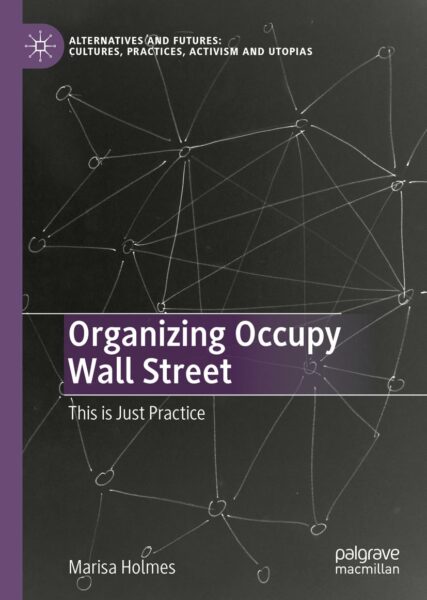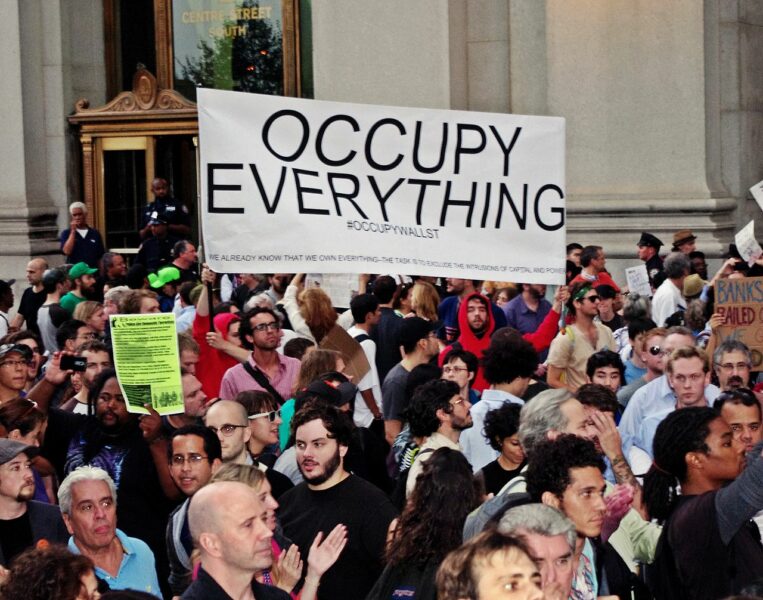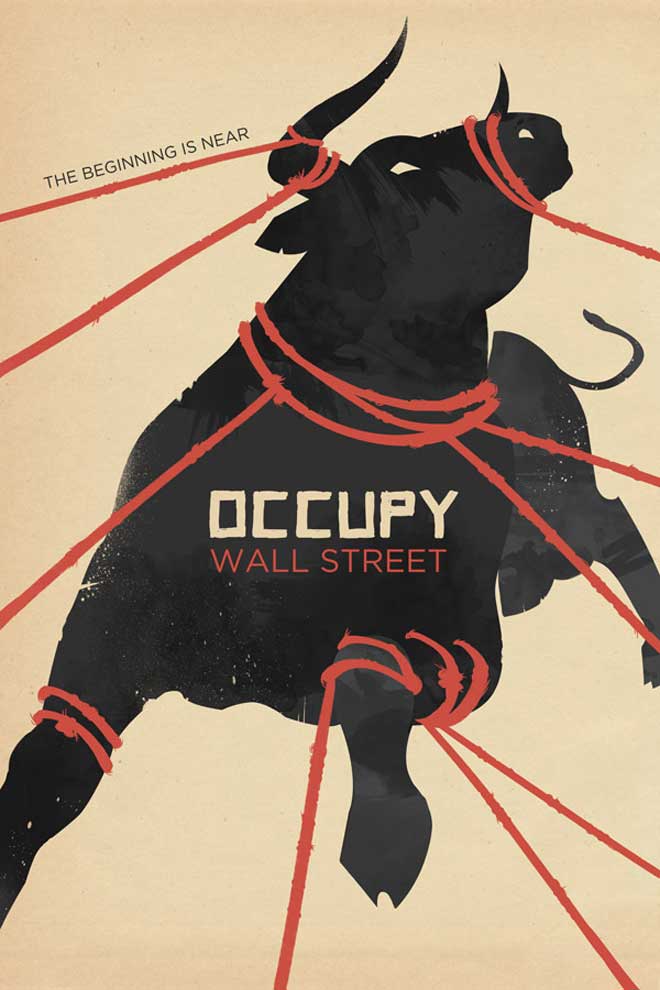Of the many words and images to come out of the Occupy Wall Street movement in the twelve years since it emerged (several of which I reviewed way back in Perspectives 2012 ‘Care’ issue), Marisa Holmes’s account stands out for several reasons.

First, it’s unique in its density of detail and the richness of its archival sources. An observant witness, keen listener, and diligent documentarian, Holmes mines a trove of primary materials: core organizers’ personal communications, planning documents, posted minutes of general assemblies, live streams and live tweets, and a personal collection of Occupy Wall Street Media Working Group videos and photos.
Second, the book illuminates Occupy Wall Street’s (OWS) location within a much larger context, connecting it to global and local movement predecessors, political and economic factors, affinities, and afterlives. The two months of the Zuccotti Park encampment in 2011, vivid and full as they are, take up less than half of the book. They’re one tip of multi-peaked iceberg.
That’s because what this book is doing is not only situating a movement history in its space and time—a noteworthy achievement in itself—but also evoking, through that movement, a dream of another kind of space and time entirely. The space of revolution, the time of jubilee, a transformation prefigured: that’s what OWS was “just” practicing.
Holmes locates OWS as the direct descendant of the Global Justice Movement (GJM) of the 1990s—2000s (see: the Zapatistas, the World Social Forums, Direct Action Network, Indymedia), and as the near relative of the wave of popular dissent that swept the globe circa 2011 (see: the squares of Greece, Spain, Quebec, and especially the Arab Spring uprisings), as well as occupations closer to home in the wake of the 2008 economic meltdown (see: Madison, WI; NYC’s Bloombergville).
By way of her own OWS origin story, Holmes recounts her visit to Cairo as a recently graduated student activist and sympathetic independent journalist, going to speak to brave organizers of Egypt’s April 6 Youth Movement. Like the experienced facilitator of general assemblies she came to be, she provides generous space throughout the book for the words of these activists and many others in Europe, North Africa, and the United States.
Offering an engrossing chronicle from a deep insider’s perspective, Holmes then takes us step by step from the formation of the New York City General Assembly (NYCGA) to the tactical preparations for taking and holding space in NYC’s Financial District, to the emergent complexities of Zuccotti Park’s mini society.
Zuccotti Park is a “privately owned public space”—a zoning category created to give real estate developers a loophole in skyscraper regulations—in the Financial District in lower Manhattan. It’s two blocks northwest of the actual Wall Street, whose very name is shorthand for finance capitalism and its depredations; a few blocks north of the bankruptcy court, from which long lines had straggled in 2008; and just southeast of the World Trade Center 9/11 memorial site.
The activists who spent the night there on September 17, 2011 couldn’t have predicted what would happen. This wasn’t a case of “if you build it, they will come,” but rather, if people come, they will build stuff. Like a potluck, the occupation coalesced from many decentralized sources. Everyone brought something. Someone saw a need, someone had an idea, someone took initiative to coordinate collective efforts to fulfill it. An anecdote of a confrontation with police near the NY Stock Exchange summed this up: accused of producing a gathering of people by means of their speech, activist Jez Bold retorted, “I didn’t produce a gathering of people. A gathering of people produced itself!” (43)
From Holmes’s account, we learn how NYCGA processes evolved into modified consensus; how a Declaration of the Occupation, Statement of Autonomy, and Principles of Solidarity were crafted through hours of discussion; how the encampment grew into a proliferating ecosystem of working groups and caucuses as needs arose; how it felt to sleep under the sky in a state of heightened awareness and altered time-flow. Holmes describes each march, action, police attack, emergent structure, and media message streaming out to the world. But, she emphasizes,
“Most of what occurred day to day in OWS, the space of the square, was mutual aid. Whether making shelter, cooking meals, providing medical attention, curating books, or coordinating media for the movement, working groups self-organized to meet immediate needs. Much of this infrastructure was inspired by previous prefigurative organizations and movements. The basic framework was started by those of us from the NYCGA. However, the practices evolved as new needs arose in the course of the occupation.” (63)
When progressive unions, politicians, and non-profits expressed support, they didn’t fully understand the point of what they were seeing. What they mistook for a distraction from the “harnessing” of all that energy into campaigns, contracts, or winnable policy compromises, was actually more significant. As Holmes tells it, the Occupiers weren’t trying to make asks of the old world, assuming its continued power, but instead to set out operating principles for a new world based in the principles of horizontality, radically participatory democracy, mutuality, solidarity, direct action, autonomous self-organization, and anti-oppression values of care and inclusivity.
The slogan perhaps most identified with OWS was “We…are…the 99%!” Highlighting the blatant inequities of neoliberal capitalism, 99% was “shorthand for those who did not have power in society,” unlike the 1%, who monopolized access to wealth and political influence. To be among the 99% was therefore to claim “an identity that included many identities,” a badge of solidarity connecting people of varying classes, races, genders, sexualities, ages, and abilities, although it also risked eliding differences between these experiences. (41)
Other iconic slogans included “Banks got bailed out, we got sold out,” and “All day, all week, Occupy Wall Street.” For the OWS movement, the claiming of physical space was paramount. But space could also be mental, institutional, or cultural. In Holmes’s formulation, to “occupy” something is to transform it, directly democratize it, and seize it back from the logics of capitalism and authoritarian power. It is to barge into whatever has been privatized, reified, quantified, commodified, exploited for the accumulation of surplus, and reclaim it from enclosure—like the whole Manhattan grid system mapped out 200 years before OWS, the better to manage the city efficiently and extract maximum value from its real estate. OWS was subtly delegitimizing the “privately owned” part of Zuccotti Park’s “public space” designation. Holmes quotes George Caffentzis, who said, “The truly subversive intent of the occupy site is to transform space into a commons . . . opened by those who occupy it, i.e. those who live on it and share it according to their own rules.” Holmes then comments, “Transforming a public space into a commons is what so terrified the state, for it undermined the very basis of its existence, and ability to maintain control.” (145)
This transformation was disrupted when police evicted the encampment on November 15. Attempts to reoccupy the park or establish an encampment elsewhere didn’t take. Yet OWS-related organizational structures continued to operate, in exile, you might say.
Holmes is just as exhaustive in documenting post-Zuccotti developments, such as attempts to partner with labor unions and student groups, injecting their efforts with the radicalizing spirit and values of OWS. She tracks the flow into two main streams emphasizing student debt (Occupy Debt, targeting universities in NYC) and ecology (Occupy the Pipeline, targeting Spectra energy’s natural gas pipeline through the city). She details intensive coalition mobilizations for May Day, 2012 (targeting immigrant justice as well as labor rights), and for the OWS anniversary in fall of 2012. Shortly afterward, Superstorm Sandy created an opportunity for OWS’s mutual aid networks to spring into action for disaster relief.
Meanwhile, the global movement, of which OWS was one branch, continued into 2013.

Holmes reports on Agora99 in Madrid, Firenze 10+10 (European Social Forum), and the World Social Forum in Tunisia, where OWS’s international counterparts were attempting, in effect, to “occupy” these institutions—to re-radicalize them, bringing them back to their horizontalist grass roots. In this way, Tunis marked a return full circle, twice over: reconnecting with the origin point of the wave of Arab Spring uprisings that had inspired the OWS instigators, and with the stream of the Global Justice Movement, which Holmes credits as an OWS predecessor.
A movement looks both back and forward, learning as it goes. OWS wasn’t perfect; but practice makes progress, as teachers say. Holmes is clearheaded about problems and shortcomings: for example, regarding race and gender equity, with attempts to redress them respectively through the People Of Color Caucus and Safer Spaces committee; tensions around control of funding, resources, and social media narratives; the emergence of informal hierarchies; the dangers of repression, cooptation, and counter-revolution. The movement faced all of this. Yet its spirit persists.
Holmes recalls, evoking the glory days of Zuccotti Park,
“Passing through the red arches of [Mark di Suvero’s sculpture] ‘Joie de Vivre’ [at the southeast entrance to the park] was like entering a portal to another world. All that one thought they knew, that had been taken for granted, was useless in this reality. It had its own energy and rhythm, driven by drumbeats, mic checks, and constant conversations. This could not be reduced to mere slogans or talking points. It could not be explained. To fully understand, you’d have to feel it in your body. Once you were there, you would be compelled to stay indefinitely.” (63-4)
For a while, Holmes dwelled in that place 24/7. Maybe someday, with practice, through practice, we could all live there, all the time. Here’s Diego Ibanez, a speaker at a press conference for May Day, 2012 (producing the effect of a pulsing poetry when transcribed in the rhythm of the people’s mic):
“I know of a place. A place that we all have the keys to. I know of a place. Where your economic class. Does not determine your social worth. I know of a place. Where there is not charity. But radical mutual aid. I know of a place. Where each conversation. Has revolutionary potential. I know of a place. Where a comprehension of the world. Has not been short circuited. I know of a place. Where we have not been blinded and tricked. Into thinking that the world has to be this way. We’ve all felt this place. On May 1. Let’s go to this place together…” (181)
Or are we sometimes already there? Holmes draws us a map:
“Wherever there are people who insist on acting as if they’re already free, the spirit of OWS is present. OWS lives in occupations of public space, and squats. It lives in rank and file independent labor actions such as work stoppages, strikes, and sabotage. It lives in direct actions during pipeline campaigns to protect water. It lives in the refusal to pay all unjust debts credit…It lives in prisoners struggling inside, and supporters outside. It lives in immigrants and refugees breaking down borders. It lives in actions against police murders, abolition, and black liberation. It lives in indigenous struggles to defend and reclaim land. It lives in those reclaiming Pride from corporations and police. It lives in LGBTQI+ liberation. It lives in feminists challenging all concentrations of dominate power…It lives in disabled bodies asserting autonomy and fighting for healthcare. It lives in neurodivergent folks fighting for mental health support. It lives, perhaps most of all, in the ever-expanding networks of mutual aid, providing material assistance and care to one another. OWS lives on, if not always in name, in practice.” (320-1)
To call the OWS movement of 2011 “just practice” could mean either a praxis of justice, or only a rehearsal. Indeed, Holmes saw it as “a break with the past and a rehearsal for the future.” (xxi) (See: akin to what Holmes describes, Shane Burley’s space of protest in Why We Fight. Though reconnecting rather than breaking with the past, see also: Rehearsals for Living by Robyn Maynard and Leanne Betasamosake Simpson. For a compendium of other such practices, traditions, and experiments with many roots around the world, see: Pluriverse: A Post-Development Dictionary edited by Ashish Kothari, Ariel Salleh, and Arturo Escobar.) Rehearsal is precisely how praxis is realized over and over, embodied through iteration, becoming second nature. If we could occupy everything, everywhere, all at once, would we be inverting the utopian Nowhere? Let’s see, Holmes suggests. Let’s try.
Maia Ramnath is the author of Decolonizing Anarchism: An Antiauthoritarian History of India’s Liberation Struggle (IAS/AK Press, 2012), and Haj to Utopia: How the Ghadar Movement Charted Global Radicalism and Attempted to Overthrow the British Empire (University of California Press, 2011). Maia was a longtime member of both the Perspectives on Anarchist Theory collective and the IAS and lives in New York City.
(Cover image by Alexandra Clotfelter)


There’s also a book called Reflections on Occupy by Steve Dustcircle . . . Short criticism on how the one in Ohio ended up.